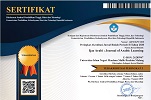Preliminary Norms Of Translating Arab Spring Dystopian Novels To English: A Paratextual Analysis Of The Queue And Seasons Of Martyrdom Novels
Abstract
Translated Arabic novels provide insight into the social, cultural, and identity aspects of Arab nations, yet translating these works is complex due to cultural nuances and varying norms. This research explores the preliminary norms influencing the selection and translation of Arabic novels into English post-Arab Spring, using The Queue by Basma Abdel Aziz (2013, translated 2016) and Season of Martyrdom by Jamal Naji (2015, translated 2016) as case studies. Applying Toury’s (2012) theory of translation norms, the study shows how social, educational, and political factors shape translation choices and impact cross-cultural communication. The study explores how sociopolitical contexts, market demands, and publishing trends shape which narratives are deemed suitable for translation and how these choices reflect broader global perceptions of the Arab world. The analysis employs Gideon Toury’s Descriptive Translation Studies (DTS) framework, focusing on both preliminary norms—such as selection criteria and translation policies—and paratextual elements, including cover design, prefaces, and promotional material, which impact the reception and interpretation of the translated works. The findings reveal that the selected novels are framed to emphasize themes of resistance, identity, and reform, highlighting the complex interplay between literature, politics, and translation. This research contributes to a deeper understanding of the role of translation in shaping the global literary representation of the Arab Spring.
Keywords
Full Text:
PDFReferences
Alblooshi, F. (2021). The Role of Paratextual Elements in the Reception of Translation of Arabic Novels into English. Kent State University.
Aldawood, S. (2017). Representing the Other in the Translation of Culture-Specific Elements in Literary Texts: Wolves of the Crescent Moon as a Case Study. International Journal of Language and Linguistics, 4(2), 29-40.
Al-Fouzan, N. (2019). Cultural Norms in Translating Children's Literature. Arab World English Journal (February 2019) Theses ID, 229.
Alkharashi, N. (2016). Modern Arabic Fiction in English: The Yacoubian Building; a Case in Point. CLINA Revista Interdisciplinaria de Traducción Interpretación y Comunicación Intercultural, 2(1), 43-59.
Alzghoul, M. (2018). Translation and Conflict: Arab-Spring Uprisings and Their Impact on Translation from Arabic into English. (Doctoral dissertation, Binghamton University
Anati, N. (2020). A Voice from the Middle East: Political Content in Arabic Children's Literature. International Journal of Child, Youth and Family Studies, 11(1), 71-91.
Bakker, B. (2021). Egyptian Dystopias of the 21st Century: A new literary trend? Journal of Arabic and Islamic studies, 21, 79-94.
Elmeligi, W. (2021). Islands, Rooms, and Queues: Three Tropes in Arabic Science Fiction. MOSF Journal of Science Fiction, 4, 36-49.
Ettobi, M. (2015). Translating orality in the postcolonial Arabic novel: A study of two cases of translation into English and French. Translation Studies, 8(2), 226-240.
Genette, G. (1997). Paratexts: Thresholds of interpretation (No. 20). Cambridge University Press.
Ismail, S. H. (2015). Arabic Literature into English: The (Im) possibility of Understanding. Interventions, 17(6), 916-931.
Jaquette, E. (2018) .Anatomy of a (Translated) Page: Basma Abdel Aziz’s The Queue.www.mhpbooks.com.
Khan, R. J. I., Kumar, T., Supriyatno, T, & Nukapangu, V. (2021). The phenomenon of Arabic-English translation of foreign language classes during the pandemic. Ijaz Arabi Journal of Arabic Learning. Vol. 4 No. 3 (October). 570-582. DOI: 10.18860/ijazarabi.v4i3.13597
Khan, R.M.I., Shahbaz, M., Kumar, T., & Khan, I. (2020). Investigating reading challenges faced by EFL learners at elementary level. Register Journal. 13(02), 277-292.
Kress, G., & Van Leeuwen, T. (2020). Reading images: The grammar of visual design. Routledge.
Kumar, T., & Supriyatno, T. (2021). Revisiting the theory of translation: Investigating the translation Divan-e Hafiz. Ijaz Arabi Journal of Arabic Learning. Vol. 4 No. 2 . 457-467. DOI: https://doi.org/10.18860/ijazarabi.v4i2.12036
Lefevere, A. (2016). Translation, rewriting, and the manipulation of literary fame. Taylor & Francis.
Marusek, S. (2022). Tomorrow and tomorrow and tomorrow: social justice and the rise of dystopian art and literature post-Arab Uprisings. British Journal of Middle Eastern Studies, 49(5), 747-768.
Nash, G. (2017). Arab voices in western writing: The politics of the Arabic novel in English and the Anglophone Arab novel. Commonwealth Essays and Studies, 39(39.2), 27-37.
Nazemian, R., & Bayati, M. (2019). Multiple Beginnings and its Relation to the Novel in the Story of “Endama Tashikh al-Zeab” by Jamal Naji. Rays of Criticism in Arabic and Persian, 9(34), 9-36.
Machado, C. M. (2016, May 15). The Queue' Carries on A Dystopian Lineage. Book reviews. NPR Web site. Retrieved January 20,2020, from https://www.npr.org/2016/05/05/476048221/the- queue-carries-on-a-dystopian-lineage
Mohamed, E. (2021). Transculturation in a Changing Arab World: Engaging Contexts in Conversation. Cultural Production and Social Movements after the Arab Spring, 13.
Moqattash, R. E. A. (2017). Chapter one from theory to practice: Literary translation between visibility and invisibility. In Translation across time and space (Vol. 1).
Qutait, T. (2020). The imaginary futures of Arabic: Egyptian dystopias in translation. Textual Practice, 34(5), 743-759.
Shamma, T. (2016). Arabic Literature in Translation: Politics and Poetics. CLINA: An Interdisciplinary Journal of Translation, Interpreting and Intercultural Communication, 2(1), 7- 11.
Toury, G. (2012). Descriptive translation studies-and beyond. revised version. Amsterdam and Philadelphia: John Benjamins Publishing Company.
DOI: https://doi.org/10.18860/ijazarabi.v8i1.32095
Refbacks
- There are currently no refbacks.
Copyright (c) 2025 Abdelrauof Alharahsheh, Tribhuwan Kumar
License URL: https://creativecommons.org/licenses/by-sa/4.0/












